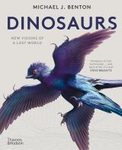Popular Science
By: Michael J Benton(Author)
296 pages, 8 plates with 16 colour photos and colour illustrations; 42 b/w photos and b/w illustrations
![Extinctions Extinctions]()
Click to have a closer look
About this book
Contents
Customer reviews
Biography
Related titles
About this book
A journey through the great mass-extinction events that have shaped our Earth.
Drawing on the latest research, this timely and original book lays out the current scientific understanding of mass extinction on our planet. Cutting-edge techniques across biology, chemistry, physics and geology have transformed our knowledge of the deep past, including the discovery of a previously unknown mass extinction. This compelling evidence, revealing a series of environmental crises resulting in the near-collapse of life on Earth, illuminates our current dilemmas in exquisite detail.
Beginning with the oldest, Professor Michael J. Benton takes us through the 'big five' die-outs: the Late Ordovician, which set the evolution of the first animals on an entirely new course; the late Devonian, apparently brought on by global warming; the cataclysmic End-Permian, also known as the Great Dying, which wiped out over 90% of all life on Earth; and, book-ending the age of the dinosaurs, the newly discovered Carnian Pluvial Event and the End-Cretaceous asteroid. He examines how global warming, acid rain, ocean acidification, erupting volcanoes and meteorite impact have affected conditions on Earth, the drastic consequences for global ecology, and how life in turn survived, adapted and evolved.
Benton's expert retelling of the scientific breakthroughs are illustrated throughout with photographs of fossils and fieldwork, scenes from the laboratory and artistic reconstructions of ancient environments that bring us face-to-face with long-lost life forms. We learn how scientists have developed revolutionary new tools to uncover ancient extinction events and processes in forensic detail, how they model evolving systems, and how they are honing their methods to improve our understanding of the deep past. New research allows us to link long-ago upheavals to crises in our current age, the Anthropocene, with important consequences for us all.
Contents
Preface
Part 1. The Late Ordovician Mass Extinction
1. The First Animals and First Mass Extinctions
2. The Cambrian Explosion
3. The Late Ordovician Mass Extinction
Part 2. The Late Devonian Mass Extinctions
4. The Devonian Crisis
5. Impacts of Global Warming
Part 3. The End-Permian Mass Extinction
6. The Greatest Crisis of All Time
7. Triassic Recovery
Part 4. The End-Triassic Mass Extinction
8. The Carnian Pluvial Event and Origin of the Dinosaurs
9. The End-Triassic Extinction
10. The Universal Hyperthermal Crisis Model
Part 5. The End-Cretaceous Mass Extinction
11. The Angiosperm Terrestrial Revolution
12. The Day the Dinosaurs Died
13. Recovery and Building of Modern Ecosystems
Part 6. The Anthropocene
14. The End of the Ice Age
15. The Industrial Age
Customer Reviews
Biography
Michael Benton is a professor of Vertebrate Palaeontology and head of the world-leading Palaeobiology Research Group at the University of Bristol. He has written more than fifty books, including Dinosaurs: New Visions of a Lost World, The Dinosaurs Rediscovered and When Life Nearly Died, all published by Thames & Hudson. He was awarded an OBE for services to Palaeontology and community engagement and regularly appears in the media to discuss dinosaurs and understanding the history of life.
Popular Science
By: Michael J Benton(Author)
296 pages, 8 plates with 16 colour photos and colour illustrations; 42 b/w photos and b/w illustrations
"If you want to know how extinctions happen and how the fossil record is relevant to understanding our current biodiversity crisis, read this delightful book about death and the resilience of life!"
– Steve Brusatte
"Combining the latest paleontological research with findings from his own expeditions, it's a meticulously researched work"
– Observer
"Fast-paced, clear and doesn't skimp on the drama"
– New Scientist
"Benton's tone is refreshing [...] authoritative but readable, modest, occasionally witty and never pompous"
– Geographical
"A brilliant account by a world-leading professor of palaeontology [...] extremely clear on what is a gripping story"
– The Biologist
"Here, the focus is on life, not death, during this lightspeed journey through its history on Earth. Empowers the reader to act instead of paralysing them, and highlights the relevance of the Earth sciences in tackling one of the most pressing problems of our time"
– Geoscientist


























![Pravěký Svět Zdeňka Buriana, Kniha 2: Monstra Třetihor a Čtvrtohor [The Prehistoric World of Zdeněk Burian, Volume 2: Tertiary and Quaternary Monsters]](http://mediacdn.nhbs.com/jackets/jackets_resizer_medium/26/263198.jpg?height=150&width=108)



















